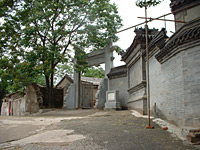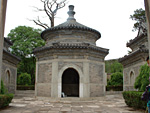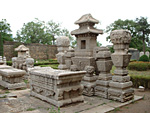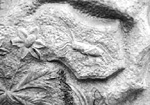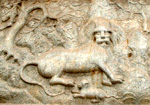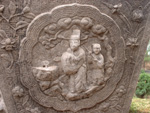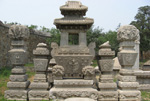Related reading:
Chinese history has witnessed a group of sexually impotent males who were forced to act as royal servants their entire lives. These men were deprived of the right to marry and have descendants. Some even lost their ability to control their urine.
Sometimes they were treated like dirt; sometimes they stood at the apex and wielded immense power. Their tragedy and pomposity were brought about by a sole reason: they served the supreme sovereigns – the emperors and their family.
When the last eunuch, Sun Yaoting, passed away in 1996, a unique group of people dating from China's feudal dynasties finally disappeared.
Now the revision of a Beijing museum has again focused public attention on eunuchs. This museum concentrates on eunuch culture and even contains the tomb of a eunuch, which is scheduled for renovation. The museum will reopen next July. Museum authorities explained that this is China's only Eunuch Culture Museum, located at the Tian Yi Tomb. The tomb, containing the remains of a Ming Dynasty eunuch, is the best-preserved eunuch mausoleum in China.
(Click to see larger pictures. Photos by Wang Zhiyong/China.org.cn)Why has the tomb been so well preserved? What kind of eunuch culture will this museum present to the public? With the help of constant in-depth interviews by the Weekend reporters, the mysteries of the eunuchs gradually unveiled themselves, revealing periods of history full of treachery, absurdity, humiliation and bitterness.
8 yuan entrance ticket Deeply affected by traditional culture, when mentioning eunuchs, people tend to angrily picture in their mind treacherous court officials performing in whiteface on the stage, such as Zhao Gao of the Qin Dynasty (221 BC – 206 BC) and Wei Zhongxian of the Ming Dynasty (1368 – 1644). What is the function of this Eunuch Culture Museum – to seek redress for these perfidious eunuchs or to continuously denounce them?
"The primary function of the museum is to record the lives of eunuchs," said Pang Xianhui, Curator of the Beijing Eunuch Culture Museum. "Some of eunuchs caused many calamities to the nation and the people in the history but most of them were not that powerful. Since the moment their external genitals were removed, they were branded with the mark of 'lowly servants.' They were inferior to others. We neither seek rectification for them nor do we condemn them. We just want to help people understand how these eunuchs lived."
The Eunuch Culture Museum first opened to the public in 1998. Only about several thousand people came to visit it each year. "Most of the visitors are foreigners."
The entrance ticket only costs 8 yuan.
From eunuch tomb to kindergarten
In Chinese history, two big tomb groups were built for the Ming Dynasty eunuchs in Beijing West Mountain area: one is the Biyunsi tombs, with the tomb of Wei Zhongxian as the most magnificent. But Wei's tomb was destroyed upon the order of Qing Emperor Qian Long. Another tomb group is the West Mountain Eunuch tombs; it witnessed various scourges, with most of the tombs demolished. The only well-preserved crypt is the Tian Yi Tomb; it remains the last completely preserved eunuch tomb in Beijing.
According to Pang Xianhui, Tian Yi, the tomb's owner, had a very good reputation. Ming history contains many positive records about Tian Yi so he didn't go experiencing the same fate as other eunuchs -- their bodies were dug out after their deaths even though they lived powerfully when alive.
Pang said that the museum was once the Cixiang Nunnery, inhabited by monks and nuns and the eunuchs who guarded Tian Yi's tomb. After the fall of Ming Dynasty, many Qing Dynasty eunuchs donated money to improve the Cixiang Nunnery out of their admiration for Tian Yi. Some eunuchs went to the nunnery to become monks after they were driven out of the palace due to their advanced age. They came to protect Tian Yi's tomb and end their lives in the nunnery.
"This is why Tian Yi's tomb was soundly preserved despite changes in dynasties," said Pang.
The tomb was greatly damaged during the era of the Republic of China. "During that chaotic era, several warlords pillaged Tian Yi's tomb and stole many treasures to raise troop funds. Luckily, the overall bearing of the tomb was not destroyed and the structure of the tomb was well preserved," Pang noted.
"The mausoleum was turned into a kindergarten by the Beijing Municipal Commission of Education (BMCE) in the 1950s. To protect the children's safety, the back entrance of the mausoleum was sealed off and no one was allowed to enter," Pang remarked smiling. "This rule consequently protected it from several rampages."
"The cultural heritage administration requisitioned the Tian Yi Tomb from the BMCE in 1998. Then the Eunuch Culture Museum was built at the Tian Yi Tomb; it was opened to the public on September 10 of that year."
Working staff with the Shijingshan Cultural Heritage Administration of Beijing stated that the museum is now under renovation, financed by a budget of 860,000 yuan. The renovations will be completed by the end of this year. During the renovations, the Tian Yi Tomb remains open to the public.
Since it is the only Eunuch Culture Museum, then what does the collection consist of? And how will these collections demonstrate the eunuchs' real lives to the public?
"We'll try to restore an authentic scene regarding the castration room," Pang said. "Castration was the greatest agony each eunuch had to suffer -- not just being wrecked physically but also losing their basic functions as a man. For the eunuchs, the castration room was even more important than the emperor's bedroom.
As the museum is still under renovation, relics destined for the castration room have not been fully assembled.
Besides the castration room, the main section of the 400 square meter museum contains exhibition boards that introduce the history of China's ancient eunuchs. Pang also expressed his wish to collect more eunuch relics from society at large.
"The current collections are mainly articles donated by Sun Yaoting, the last eunuch, before he died, with the most precious item being a yellow jacket granted to him by Emperor Fu Yi," Pang remarked.
(China.org.cn December 7, 2007)

